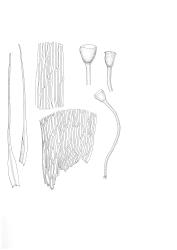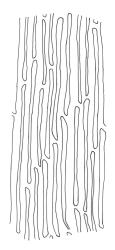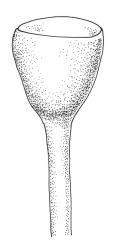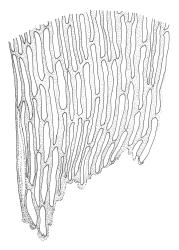Elements in the following description are taken from Bartlett & Vitt (1986).
Plants yellow-brown in emergent portions, dark brown to black below (or throughout) when submerged, moderately glossy. Stems not wiry, c. (10–)30–60 mm, moderately branched by innovation and forking, with 2–3 thick-walled cortical cell layers and a small central strand, with leaf fragments not conspicuously adherent. Leaves erect-flexuose to loosely falcate-secund when moist, not penicillate, little altered when dry, with an oblong-lanceolate base of (1.0–)1.2–2.0 mm and ± gradually or ± abruptly narrowed to a long and slender subula which is (2–)3–4 times the length of the base, not distinctly shouldered, entire throughout or crenulate above, subtubulose, clasping at base, 5.0–9.0 × 0.4–0.6 mm (when flattened); upper laminal cells (from upper portion of base) linear and ± straight, incrassate, c. 60–120 × c. 4 µm, but with the lumina mostly expanded at leaf ends; lower laminal cells similar; alar cells nearly always absent from removed leaves. Costa (40–)70–90(–100) µm wide, ill-defined at base, filling the subula, in cross-section with a moderately-defined median layer of guide cells (near base of the subula).
Autoicous. Perichaetia terminating the stem or branch, apparently sometimes overtopped by innovation, the perichaetial leaves more abruptly shouldered and more clasping than vegetative leaves. Perigonia rather large, often occurring at tips of innovative branches, with inner perigonial bracts short (c. 1.0–1.5 mm), strongly shouldered, and lacking a long subula. Setae 8–12 mm, flexuose-erect, twisted to the right when dry, little altered when moist, orange; capsules turbinate and wide-mouthed when dry, turbinate or obovoid when moist, exserted, black, pachydermous, c. 1.0 × 0.8–1.0 mm; exothecial cells highly irregular in shape and size, mostly longer than wide, incrassate, weakly collenchymatous, c. 2–3 rows oblate at rim; stomata not seen; operculum conic-rostrate, ± oblique. Peristome well-developed, but fragile and often missing, the 16 teeth lanceolate and acute, the outer surface densely and coarsely cribose-warty below (apparently due to preperistome development). Spores variable in size in a single capsule, (16–)21–36(–40) µm, smooth, green.
Bartlett & Vitt 1986, figs. 85–100, 156; Seppelt 2004, fig. 101.
I agree with Bartlett & Vitt (1986) that this species is probably closely related to B. robusta. The vegetative leaves in B. seppeltii have a more defined base that tapers more abruptly to the subula than the leaves of B. robusta. The taper in B. seppeltii is emphasized by the subtubulose nature of the leaf base but appears more gradual when the leaf base is gently flattened on a microscope slide. The wider and ill-defined costa further distinguishes this species from B. robusta. With rare exceptions alar cells are not present in removed leaves, although a well-differentiated alar group of c. 15 inflated cells has been seen in D.H. Vitt 8977 from Auckland I. (CHR 412478).
Although Bartlett & Vitt (1986) suggest that the seta here is stouter than in B. robusta, I do not consider this useful to distinguish the two species. They also note a wider variation in seta length than I have observed (in the type and one other collection). The capsules available for examination were in poor condition.
A; M. Reported from C by Bartlett & Vitt (1986) and Seppelt (2004).
Endemic.
Blindia seppeltii is reported from "moist rocks and from aquatic habitats in lakes and seepages" by Bartlett & Vitt (1986). The type collection from Macquarie I. is from the edge of a small lake at 110 m elevation and grew with Ditrichum strictum and the hepatics Pachyglossa tenacifolia and Riccardia aequicellularis. Two collections from Auckland I. (P.N. Johnson 20/35, WELT M027147 and P.N. Johnson 15/16, WELT M027146) occurred in fellfields at 480 m elevation. The first of these two collections has no identifiable associated species, while the latter grew in a mat of Ochiobryum blandum, suggesting at least some seepage.










